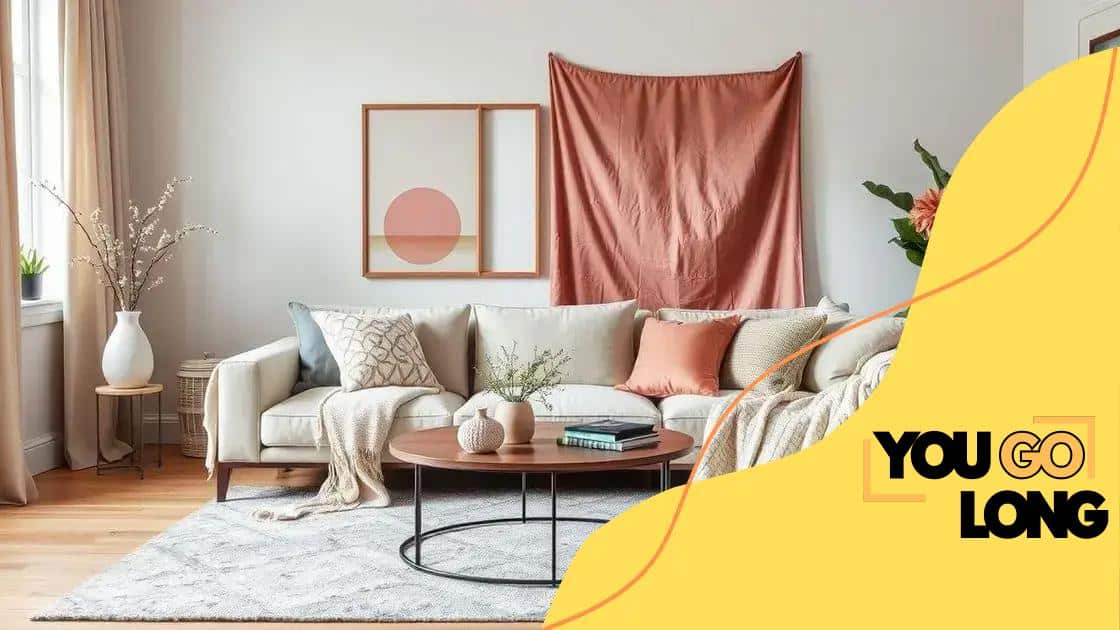How to create a cozy and stylish home with soft textiles

Advertisement
To create a cozy and stylish home with soft textiles, incorporate various fabrics, colors, and textures in each room, focusing on comfort and visual appeal.
How to create a cozy and stylish home with soft textiles is a question many homeowners ask. Imagine stepping into a space that feels inviting and comfy. With the right textiles, this can be your reality.
Choosing the right soft textiles for your home
When choosing the right soft textiles for your home, consider how they can enhance your space’s overall vibe. Soft textiles like cushions, throws, and curtains add warmth and comfort, making any room feel inviting.
Types of Soft Textiles
There are various types of soft textiles to choose from, each with unique qualities:
Advertisement
- Fabrics: Options like cotton, linen, and velvet can give your home a distinct touch.
- Patterns: Floral, geometric, or striped designs can create focal points in a room.
- Colors: Soft, neutral colors can bring tranquility, while bold hues can energize a space.
It’s essential to think about how these textiles will complement your existing decor. For example, a plush velvet throw can add a touch of luxury to a simple couch. In contrast, linen cushions provide a more casual and breezy feel.
Functionality and Comfort
Besides aesthetics, functionality plays a significant role in your textile choices. Look for durable fabrics that can withstand daily use. Also, soft textiles should provide comfort. For instance, a floor rug can be both decorative and cozy underfoot.
Consider layering your soft textiles to create depth. For example, pile various cushions in different textures and colors on your sofa. This approach gives a relaxed, inviting atmosphere. Always remember that soft textiles should not only look good but also serve their purpose well.
Advertisement
Finally, don’t overlook the practical side. Some fabrics are easier to clean than others. Choose machine-washable options for frequently used items like throws and pillow covers. This consideration will save you time and keep your home looking fresh.
Layering textiles for a stylish look
Layering textiles for a stylish look can transform any room into a warm and inviting space. By combining different fabrics and textures, you can create depth and interest within your decor. This method not only adds visual appeal but also enhances comfort.
Why Layer Textiles?
Layering textiles allows you to play with colors and patterns. Using various materials can make a space feel more complete and curated. Imagine a couch adorned with a mix of patterned cushions, soft throws, and textured blankets. Each layer adds dimension, creating an eye-catching arrangement.
- Enhances comfort: Layering gives a cushioned effect, making spaces cozier.
- Brings out colors: A mix of textiles can highlight your color scheme.
- Adds style: Personalizes decor and showcases unique tastes.
When layering, consider starting with a base layer. This could be a solid-colored throw or a textured rug. On top of that, you can add contrasting or complementary materials. For instance, a soft wool blanket can be layered over a sleek velvet throw. This creates a cozy yet stylish look.
Practical Tips for Layering
To effectively layer textiles, aim for a balance between patterns and solids. Too many competing patterns can create visual chaos. Instead, mix bold patterns with neutral colors to let each piece shine. Don’t forget to vary the fabric textures. Combining soft materials like cotton with rougher textures like linen or burlap adds intrigue.
Remember, the goal is to create a space that feels lived in and welcoming. As you experiment, consider your personal style and how you want your home to feel. You might choose light, airy fabrics for a relaxed vibe or rich, plush textiles for a more luxurious ambiance.
Color palettes that work well with soft textiles

When considering color palettes that work well with soft textiles, it’s essential to understand how colors influence the overall mood of a space. Choosing the right colors can make your home feel harmonious and inviting. Soft textiles can enhance any color scheme by adding texture and depth.
Popular Color Combinations
There are several color combinations you can explore to complement your soft textiles:
- Neutrals: Whites, beiges, and grays create a calm base that pairs beautifully with various soft textiles.
- Pastels: Soft pinks, blues, and greens can add a gentle touch, perfect for a tranquil atmosphere.
- Bold Accents: Using bright colors, like deep blue or rich maroon, can provide striking contrasts against lighter textiles.
Using colors wisely allows you to create an environment that feels intentional and thought out. Light colors can make a space look airy, while darker shades can create a cozier, more intimate feeling.
Impact of Texture and Color
As you combine colors and textiles, think about their textures too. Mixing a smooth velvet with a rough linen can add interest to your design. For example, if you choose a soft blue velvet cushion, consider how it will look with textured beige throws. This combination can create a visually appealing depth in your decor.
Consider how natural light interacts with your chosen colors. A color that looks good in the store might appear different in your home due to varying lighting conditions. It’s always smart to test fabrics in the actual space where you plan to use them.
Maintenance tips for your soft textiles
Proper maintenance is key to keeping your soft textiles looking their best. Regular care will ensure that your fabrics stay fresh and durable over time. Here are some effective strategies to help you maintain your textiles.
Cleaning Techniques
Different fabrics require different cleaning methods. It’s important to read the care labels before washing. Most cotton and polyester blends are machine washable, while fabrics like silk or velvet may need special attention.
- Spot Cleaning: For small stains, dab the area gently with a damp cloth. Avoid rubbing, as it may spread the stain.
- Machine Washing: Use cold water and gentle cycles for most soft textiles. This preserves their color and texture.
- Dry Cleaning: For delicate fabrics, consider professional cleaning to avoid damage.
Regular vacuuming can also help keep your textiles clean. Use a soft brush attachment to remove dust and dirt without damaging the fabric.
Storage Tips
When storing your soft textiles, ensure they are clean and dry. Fold them neatly and avoid heavy items on top to prevent creasing. Use breathable storage bags to protect from dust, while allowing air circulation. Avoid plastic bags, as they can trap moisture and lead to mildew.
Additionally, consider using lavender sachets or cedar blocks in your storage area. These will keep your fabrics smelling fresh and help deter pests.
By following these maintenance tips, you can prolong the life of your soft textiles, keeping them beautiful and comfortable for years to come.
Incorporating soft textiles in every room
Incorporating soft textiles into every room can dramatically enhance the comfort and style of your home. These textiles can add warmth and personality to your space. Each room serves a unique purpose, and with the right soft textiles, you can create an inviting atmosphere.
Living Room Ideas
The living room is a space for relaxation and socializing. Start with plush cushions and layered throws on the sofa. Mix different fabrics like cotton and velvet for visual interest. Adding a large area rug can also anchor the space, providing a cozy feel underfoot.
- Cushions: Use various patterns and sizes for a dynamic look.
- Throws: Drape soft blankets over furniture for extra comfort.
- Rugs: Choose one that complements your furniture and ties the room together.
Bedroom Comfort
In the bedroom, soft textiles create a tranquil environment. Start with your bedding. Opt for fluffy quilts and-soft sheets to make your bed a cozy haven. Soft pillows can enhance comfort and support during sleep. Additionally, consider adding curtains or drapes that filter light gently, creating a serene ambiance.
Dining Room Touches
Even in the dining room, soft textiles play a role. Tablecloths or placemats can add color and texture to your table setting. Incorporate fabric napkins for an elegant touch during meals. If you have a buffet or side table, a soft runner can brighten up the space while adding interest.
Bathroom Textiles
Finally, bathrooms can benefit from the addition of soft textiles too. Use fluffy towels and bath mats to enhance comfort after a shower. Choose textiles with moisture-wicking properties to ensure they remain fresh. Adding a decorative shower curtain can also soften the overall look of your bathroom.
FAQ – Frequently Asked Questions about Incorporating Soft Textiles in Your Home
How can I choose the right soft textiles for my living room?
Look for fabrics that complement your existing decor, and consider layering different textures and colors to create a cozy atmosphere.
What types of soft textiles are best for bedrooms?
Opt for soft sheets, plush pillows, and warm blankets to enhance comfort and create a relaxing environment in your bedroom.
How do I maintain my soft textiles?
Regularly vacuum and spot clean your textiles. Follow care instructions for washing and consider dry cleaning for delicate fabrics.
Can soft textiles be used in bathrooms?
Yes, fluffy towels, bath mats, and decorative shower curtains can enhance comfort and style in your bathroom.





